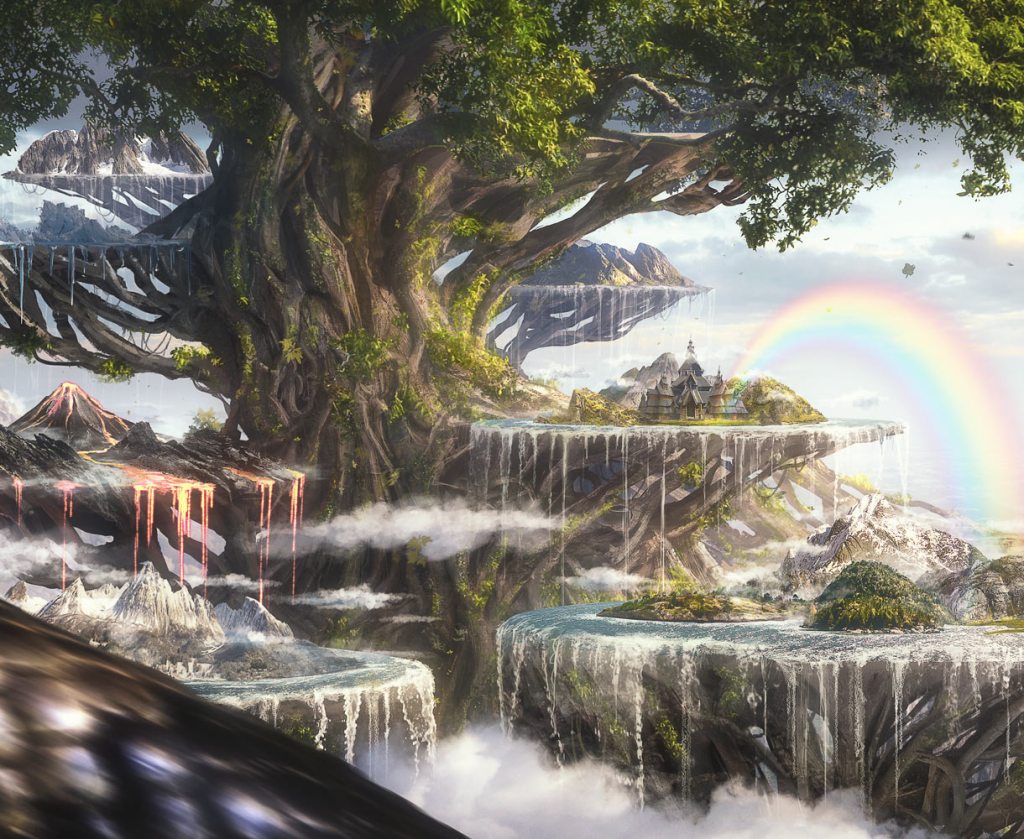Yggdrasil (Old Norse Yggdrasill or Askr Yggdrasils) is the mighty tree whose trunk rises at the center of the cosmos, with branches stretching out over all of the nine realms. Each realm hangs on its own branch and, if the tree should shake or fall, so will all the realms.

The name Yggdrasil is a mythological metaphor described in the Edda poem Hávamál. Yggdrasil is a combination of two words. Yggr, which is one of Odin’s names and means “the terrifier, the one who strikes all”. The second element, drasill, means “horse.” So Yggdrasil’s name means “Horse of Odin,” a reference to the time when the Allfather sacrificed himself to discover the runes.
The name should be understood in the context of Odin’s connection with the world tree. Odin who is always in the pursuit of more knowledge, once sacrificed himself on the tree to learn the secrets of the runes:
I know that I hung on a windy tree
nine long nights,
wounded with a spear, dedicated to Odin,
myself to myself,
on that tree of which no man knows
from where its roots run.
– Hávamál stanza 138
When Odin was hanging on the tree, he was, therefore, riding the tree as a horse. This mythological metaphor can be seen as Norse humor.
No one gave me bread nor a horn,
I looked down,
I took up the runes, screaming I took,
I fell then from there.
– Hávamál stanza 139

It was in the final moments before Odin fell from Yggdrasil, that he learned the secrets of the runes.
In Old Norse literature (Völuspá, stanzas 19, 47; Grímnismál, stanzas 35, 44), Yggdrasil is commonly said to be an ash tree, but at other times, it’s said that no one knows the species to which the magnificent tree belongs (Fjölsvinnsmál, stanzas 19, 20).
The Old Norse sources provide vivid but contradictory accounts of the number and arrangement of the roots and wells beneath the base of Yggdrasil’s trunk.
According to the poem Grímnismál, Yggdrasil has three main roots: one planted in Midgard, the world of mankind; one in Jotunheim, the world of the giants; and one in Helheim, the underworld, with the Völuspá mentioning only one well beneath the tree: the Well of Urd (Urðarbrunnr, “Well of Fate” in stanza 19), where the Norns live (read more here).
However, Snorri Sturluson, in his Prose Edda, holds that there are actually three wells beneath the tree, one for each of its roots, and that the Well of Urd, is actually in the Asgard, and the root that grows out of it bends upward into the sky.
According to the Prose Edda of Snorri Sturluson the first root is located in Helheim, deep below the thick ice in Niflheim. The well nearby this root is called Hvergelmir (Old Norse “bubbling boiling spring”), but not much is known about it. The well is mentioned in a single stanza in the Poetic Edda and very scarcely in the Prose Edda, which adds that within the spring is the dwelling place of a vast amount of snakes and the dragon Níðhöggr (Meaning: Hateful Striker), who is constantly chewing this root in an attempt to topple the mighty tree.

The second root is in Jotunheim, and at this root is the well called Mimir’s well (Old Norse: Mímisbrunnr). This is the well of wisdom, and it belongs to the wise Jotun Mimir. Everyday Mimir drinks from this well by using his drinking horn called Gjallarhorn, which shares the same name with Heimdallr’s horn.
Mimir does allow others to drink from his well, but expects a hefty payment for the benefit. Odin once drank from the well of wisdom, but he had to sacrifice his right eye as payment.

The third root is in Asgard right next to the well named Urðr (Old Norse: Urðarbrunnr). Nearby there is a great hall, where the three Norns, Urðr, Skuld, and Verðandi live (read more about them here).
Each morning these Norns draw water from the well, and collect the moist earth or clay around it, pouring it over the root of Yggdrasil. This is done to keep the world tree green and healthy and, should they fail this task, the tree will begin to rot.
The water from Urðarbrunnr is magical, and it is so sacred that everything it touches - besides Yggdrasil - will become as white as the membrane (called skjall “skin”) from the inside of an eggshell. The white color is a symbol of cleanliness, pride, beauty, greatness, light, and death. It is also at this spot that the Gods and Goddesses have their daily meetings and where they cast judgment.

Heimdallr brings forth the gift of the gods to humanity (1907) by Nils Asplund
Net week, we will talk about the animals and fantastic beast that make Yggdrasil their home.
Sources:
Jesse Byock (2005) Snorri Sturluson, The Prose Edda. 1st. edition. London, England: Penguin Books Ltd. ISBN-13 978-0-140-44755-2
Anthony Faulkes (1995) Snorri Sturluson, Edda. 3rd. edition. London, England: Everyman J. M. Dent. ISBN-13 978-0-4608-7616-2
Lee M. Hollander (1962) The Poetic Edda. 15th. edition. Texas, USA: University Research Institute of the University of Texas. ISBN 978-0-292-76499-6












